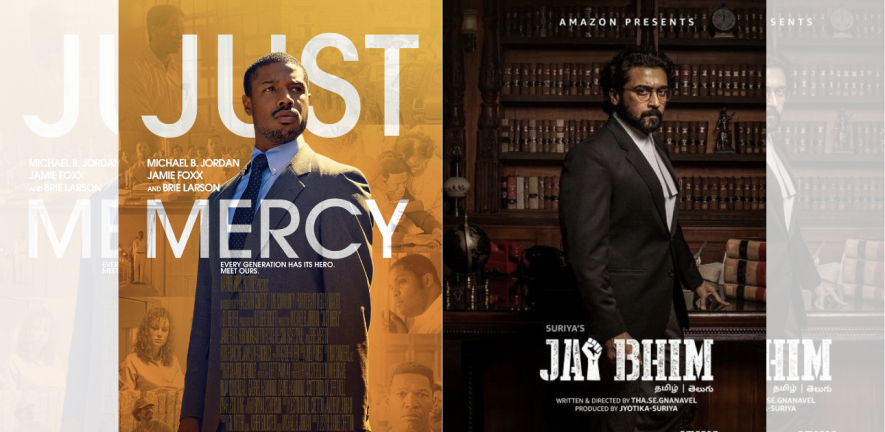A discussion of access to justice for underprivileged minorities based on their depiction in two movies. Also, a spoiler alert if you haven’t watched both.
—–
I look at two films based on real-life incidents (Just Mercy and Jai Bhim) to understand access to justice issues faced by discriminated minorities and the judiciary’s role in addressing them.
The movie Jai Bhim is based on the life of retired Madras High Court judge and former senior advocate K. Chandru. The protagonist is a cause lawyer representing an Irular (one of the oldest indigenous tribes in India) woman whose husband had gone missing from police custody. Her husband, a snake catcher by occupation, is suspected of robbing a house he had previously visited as a part of his livelihood.
The movie Just Mercy is based on the life of Bryan Stevenson, who founded the Equal Justice initiative using a grant to help death row convicts who could not afford legal assistance. Just Mercy focuses on the judicial hearings of Walter Mc Milian, who was falsely convicted and sentenced to death row for the rape and murder of a young white woman.
Similarities abound
The problem of apartheid in the United States is comparable to that of caste in India. Regarding rights, blacks were not considered citizens of the United States for a long time. In contrast, some members of the Scheduled Tribes (also known as ST, are recognized as socially disadvantaged groups in the Indian Constitution) still don’t possess documents that prove their identity as citizens, such as ration cards. Both African Americans and the ST community faced historical discrimination and continue to do so. However, the ST is also invisible regarding numbers and representation, and their voices get buried under the cries of other oppressed castes.
The type of society and the nature of the minorities that comprise this study are different and acknowledged. However, many scholars have drawn a nexus between the two. For example, the journalist Isabel Wilkerson in her work titled, “Caste: The origins of our discontents”, argues that racial inequality is a caste system.
The actual test for the accessibility of a judicial system is not whether an aggrieved person who subscribes to the majoritarian view gets justice; it is about whether a historically repressed minority can secure the same. The nation’s character is reflected in how we treat the poor, the disfavoured, and the condemned. (Just Mercy)
Misuse of procedural irregularities
In both cases, we see the procedural irregularities that occur when the police creates false evidence to convict marginalized community members wrongfully. The procedural irregularities come to light in Jai Bhim only because the Court accepted the protagonist petitioner’s counsel’s request to conduct a cross-examination even though it was a habeas corpus petition.
The Rajan case mentioned by the petitioner’s counsel as precedent had persuasive value only. If the High Court had chosen to ignore the same, maybe the petitioner would not have received justice, and the procedural irregularities would not have come to light. Both cases demonstrate how the law is a powerful weapon and what it is used for; thus becomes crucial. (Jai Bhim)
Custodial torture is a common theme in both cases to obtain a confession, which is the queen of evidence. In Just Mercy, the only eyewitness in the Walter Mc Milian trial is tortured by using his traumatic fear of getting burned by illegally imprisoning him on death row next to the execution chamber. He spent the entire night smelling the burnt flesh of the executed convict who had been sentenced to death by the electric chair. This trauma made him falsely testify against Walter Mc Milian in the murder trial leading to the latter’s conviction.
Similarly, in the movie Jai Bhim, the petitioner’s husband in the habeas corpus case and two of his kin were tortured in police lockup to make them confess to committing theft. Eventually, the petitioner’s husband succumbed to his injuries, and the police covered up his murder by alleging that the three accused had escaped custody.
Profiling of communities as perpetual outsiders
The film Just Mercy states that no one wants to remember or acknowledge the historical suffering of the Afro-American community. In the United States, they are always the prime suspects for crimes, especially in cases without leads. The essential principle of criminal law is that a person accused is not guilty until proven. But as Just Mercy states, the cruel reality is that an Afro-American person is considered guilty from birth.
Similarly, although the Criminal Tribes Act, 1871, which classified certain tribes and transgender people as criminals, has been repealed in India, the ST community is continuously targeted by police officials and prison authorities. They are regarded as habitual offenders by the police and booked for crimes they don’t commit. They are considered savage, which is used to justify the acts of violence committed by the police against them.
The opening scene of the movie Jai Bhim shows how their identity of being an ST means they are the perfect scapegoat for fake encounter cases. When the police do not find the accused in a case, and the pressure builds up from higher authorities, they resort to such inhumane methods. This type of profiling, because of the unprivileged nature of the community, highlights the problems with the justice system.
The film Just Mercy also talks about how the discriminated Afro-Americans are continuously targeted. To escape this discrimination, these communities try to integrate with mainstream society. Walter Mc Milian berates Bryan Stevenson for coming to visit him wearing suits and talking like a white person. (An illustration of the concept of covering discussed by Kenji Yoshino). However, no amount of covering helps them become insiders.
Ironical tokenism is also displayed towards the African-American community as seen by the constant reference to Harper Lee and Kill the Mocking Bird Museum by characters who obstruct the protagonist from reopening the case and proving the innocence of Walter Mc Milian.
In the film Jai Bhim, the petitioner’s husband tries to get some youngsters from the Irular community admitted into schools. Still, he fails as the community does not have proper documentation to prove their identity—this indelible outsider status further distances them from obtaining their rights. The justice system is used to misuse this vulnerability rather than protect it.
The cases won in real life, depicted in Jai Bhim and Just Mercy, are rare exceptions when these marginalized communities were given justice. The film Just Mercy ironically notes that to the Afro-American community, a delayed execution often becomes the only “good news” they hear in a long time.
Faith in the judicial process
The judiciary cannot become a hollow hope for its people. Hopelessness is the enemy of justice; hope allows us to push forward even when those in power distort the truth. (Just Mercy). Both the cases demonstrated that the judiciary is crucial to ensuring justice for marginalized communities. The petitioner’s counsel in Jai Bhim emphasizes that the habeas corpus petition is not just about custodial death, but a desperate cry for justice, and that by granting relief to the petitioner, the Court was not just giving marginalized communities justice, but hope.
The movie states that the Court’s silence in the face of injustice is the most dangerous thing that can happen to democracy and its citizens. As the watchdog of the Indian Constitution, the judiciary is responsible for safeguarding the rights of Indian citizens, especially those of indigenous communities whose voices get drowned by the misuse of administrative power.
In Just Mercy, the first time the protagonist visits Walter Mc Milian’s family, their sadness and loss of faith in the judicial system are depicted by their words; when the hard-earned money pumped into the litigation costs ran out, the lawyer also ran out. What are you going to do that is different?
Remarkable conviction
Maya Angelou says, “The caged bird sings with a fearful trill for things unknown yet longed for still”. We all have the right to be free and been granted mercy to be considered equal citizens in our respective States.
The films depict the real-life exceptions to the norm where people stood up against discrimination. They battled the prejudice that legal assistance to death row convicts meant that convicted murderers would roam scot-free on the streets, the fear created by death threats from crazy bigots (in Just Mercy), and pressure to accept compensation and settle out of court (in Jai Bhim). They laboured under the great conviction they placed on the judiciary, which fortunately paid off.
Manasvini Ranganathan is an LL.M. graduate from Azim Premji University, interested in the intersections between Law and Literature.

























